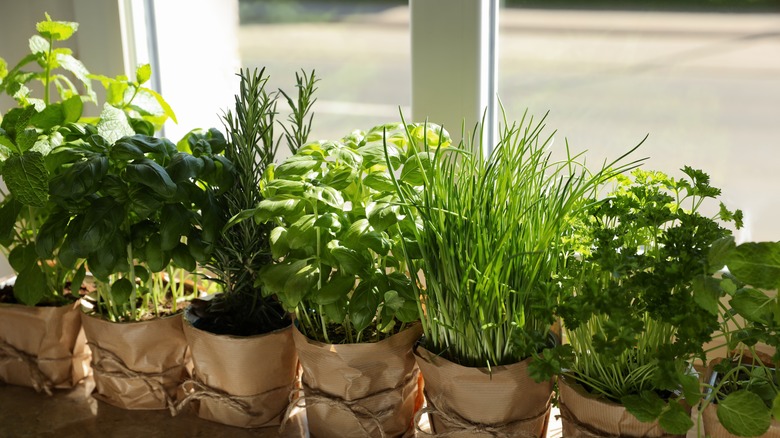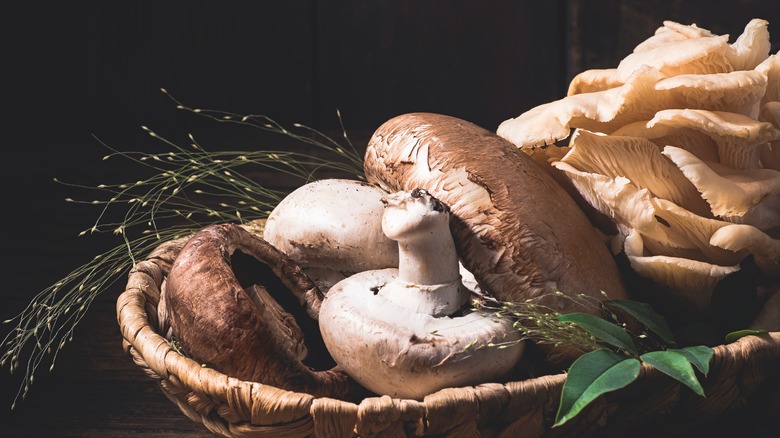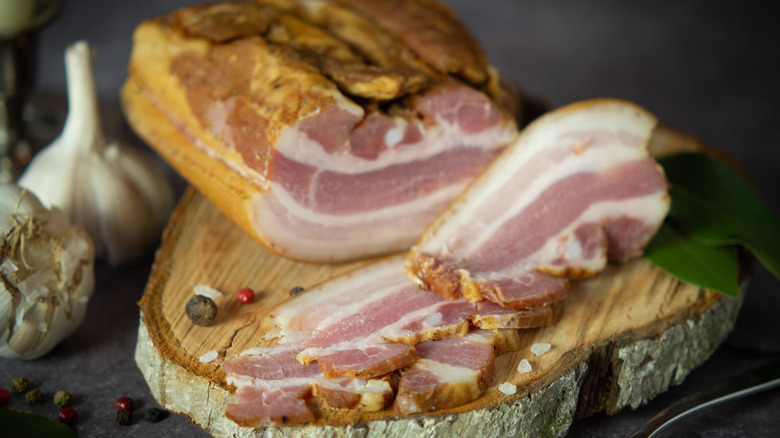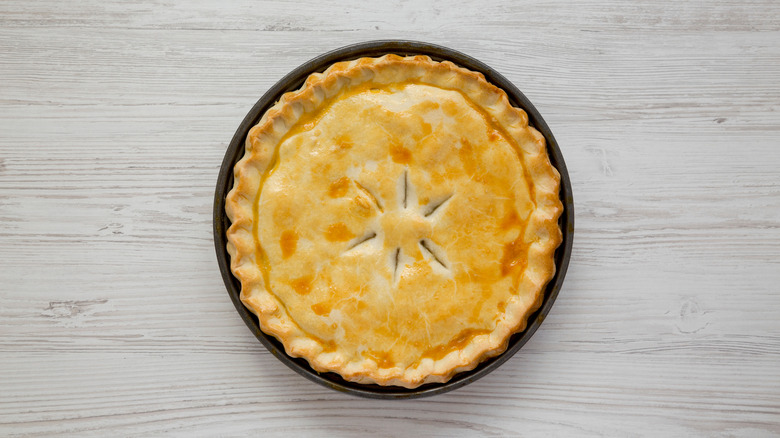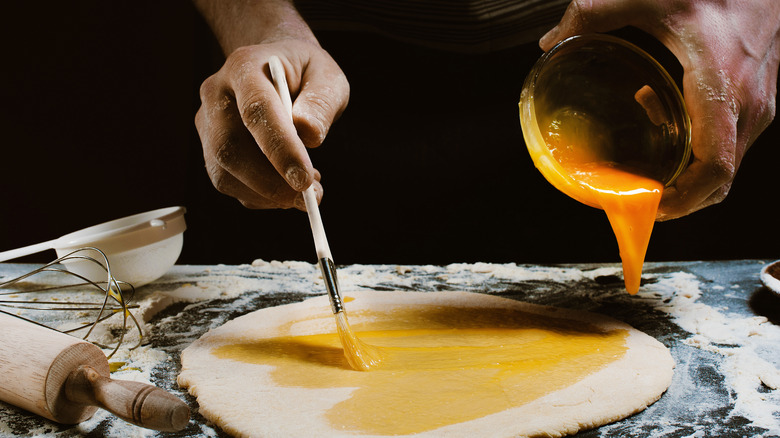14 Tips You Need To Make The Best Chicken Pot Pie
The humble chicken pot pie is a delicious and quintessential staple in the catalog of American cuisine. From its flaky crust to the creamy and flavorful filling that's packed to the brim with goodies such as chicken, peas, and potatoes, it's hard to beat the down-home comfort of a chicken pot pie. But what exactly is it? To answer this, one first needs to understand that the word "pie" describes any food, savory or sweet, that's wrapped, and/or topped with pastry dough before being baked. From the phyllo-wrapped spinach pies of Greece all the way to open-faced fruit tarts, a pie by any other name still tastes as sweet. By that logic, a "pot pie" is, quite simply, anything that's wrapped in a crust and baked in a pot.
There are two schools of thought when it comes to chicken pot pie and crust criteria. Some claim that a pot pie is not a pot pie if it has a bottom crust, while others cannot conceptualize a chicken pot pie that isn't wrapped from top to bottom in buttery layers of crispy pastry. And while there may be a technically right and wrong way to make a chicken pot pie, what matters most in the pie-making process is ensuring that the pie pleases you. After all, nothing hits that comfort food craving quite like a chicken pot pie. Bottom crust or no bottom crust, these are the tips you need to make the best version possible.
Follow a good recipe
If you're going to devote your time, energy, and hard-earned money to making a chicken pot pie, then it's essential to start from the solid foundations of a good recipe. And, while some lucky few are born into families with passed-down and perfected chicken pot pie recipes that could make even the most austere of Michelin food critics weep, not everyone is so fortunate. But hey, that's what the internet is for! And there are a few tips and tricks for narrowing down the nearly-infinite online recipe options currently available across the great wide web.
First and foremost, make sure that the recipe source is trustworthy. Secondly, cross-reference the process with a video demonstrating the proper method. This step is especially important, as having a visual aid can help in mitigating easy-to-avoid issues such as a too-wet dough or a too-dry filling (or vice versa). Lastly, and most importantly, remember to use this opportunity to develop your own chicken pot pie by writing down the recipe and taking detailed notes with each rendition. After all, this is how those coveted heirloom family recipes begin: with one person logging their recipes (triumphs and failures included) for chicken pot pie posterity.
Find fresh, quality ingredients
A chicken pot pie is a simple dish, which means every ingredient has to stand for itself. This can be achieved by forgoing the frozen veggies and boxed stock and instead rustling up some fresh poultry and produce for the occasion — perhaps at your local farmers market. It's tastier, often less expensive, and only a little more work that, if you're already making a pot pie from scratch, is well worth the extra effort. Consider the phenomena of storebought tomatoes. For those who have never experienced the joy of a fresh, vibrant, sun-ripened tomato picked at the peak of summer and plated that same day ... well, it's incomparable to the experience of eating the often tasteless, texturally compromised, oddly styrofoam-reminiscent tomatoes found in the produce section of your local grocery store. Compared to the contrast between fresh and storebought tomatoes, most produce has a significantly smaller disparity, but a disparity nonetheless.
You won't likely find tomatoes in your chicken pot pie, but the theory still applies. Most recipes for this dish require a small number of simple ingredients, so it's important to make each ingredient count. And with some carefully selected groceries treated with care, a small variety can produce some big flavors.
Use the whole chicken
A chicken, in its entirety, can be one of the most versatile and downright useful ingredients in a chef's repertoire. Don't just use the meat for the pot pie — instead, use the whole chicken, including bones and skin (and all the other little bits) to make a stock for the filling. The rich flavor of homemade stock is incomparable to the boxed stock from stores, and significantly less expensive as well. So, don't throw those bones away when you can save them for another day.
In the same spirit of utilizing the entire chicken, be sure to use both light and dark meat in the filling for a more complex array of flavors and textures in the final pie. And, for the chicken skin lovers out there, consider crisping up the skin, chopping it up, and using it to garnish the pie when it's fresh out of the oven. After all, chicken skin is the tastiest part of the bird, and it can make for a unique umami addition.
Herbs can go anywhere
Herbs are essential when it comes to the kitchen, and most recipes could do to amp up the herb content up a teaspoon or two ... or seven. This is especially true when the herbs are fresh rather than dried since they can serve to brighten up a seemingly heavier recipe; chicken pot pie, for example! Thyme, parsley, oregano, basil, sage, tarragon, chives, basil, and even dill are excellent add-ins for a pot pie. Each of these herbs can help to bring a wholly unique but wonderfully subtle quality to the dish.
Adding fresh and dried herbs alike to the pastry dough is another excellent trick that can help to add an extra layer of flavor to the pie's crust. Herbs can also be used to garnish the top of the pie (along with some flaky salt after the eggwash). Not only is this a delicious decision, but it will also add some serious aesthetic value to the final, fresh-from-the-oven pot pie.
Choose mushrooms for umami
When it comes to flavor, more is always better. And nothing adds a punch of sumptuous umami quite like mushrooms, which makes them the perfect (not so) secret ingredient to take your chicken pot pie to the next level. From throwing the stems in a stock to featuring them as a main ingredient to adding a pinch of dried mushroom powder to the filling, there's no way to go wrong by amping up a pot pie's savory factor with delicious mushrooms.
From the humble button to the proud portobello (they're actually the same mushroom, but we'll get to that later) and the chanterelles, black trumpets, and lion's manes in between, mushrooms and meat pies are a match made in heaven. And don't underestimate dried mushrooms, as they can be rehydrated with a quick soak in water, ensuring not only delicious mushrooms for the filling but mushroom-infused water that can be used and added to stock as well.
Keep the crust cold
When it comes to tips you need to make the best chicken pot pie, keeping the crust as close to ice cold as possible is perhaps the most important. Here's why: you know that delicious, flaky, crispy crust you love so much? Well, that effect is achieved by layering butter through the dough so, when it bakes, the butter melts and creates layer after layer of flaky pastry.
By that logic, what happens if the butter melts as it's being integrated? It absorbs into the flour and those layers are lost. So, keeping the crust as cold as can be is essential. That means freezing the butter if you're making the dough from scratch, letting the filling chill before putting the crust on top, and putting that pie somewhere cool to rest until the oven is entirely pre-heated. Again, keep that pot pie crust as cold as you possibly can!
Fat is flavor
There are a million and one fat-free "healthy" recipes in this world and, frankly, chicken pot pie just isn't one of them. From the buttery crust to the rich and creamy filling, every step of the pot pie process requires various forms of flavorful fat. So, be it cream, lard, or your favorite fancy butter, don't skimp out when it comes to the fats — after all, no one eats a chicken pot pie because they're craving something light. Give the people what they want with a fat-full dinner that'll stick to your ribs (and in your fondest of mealtime memories).
If health is a priority, there are better ways to achieve it than by compromising the integrity of a pot pie. Rather than cutting back on the fat, consider amping up the vegetable content of the filling, having a smaller slice, and serving the meal alongside a perfectly paired and prepared salad. Who knows, maybe combining a chicken Caesar salad with chicken pot pie is a revolutionary combo just waiting to be added to the culinary canon.
Add some pork (of any sort)
At this point, adding bacon to amp up a recipe is basically a given — but what about lardons, pancetta, guanciale, some simple cubed ham, or even chorizo for a fusiony pop of flavor in an otherwise traditional chicken pot pie? There are so many different pork cuts and products to add to a pot pie that will absolutely blow the minds of everyone who gets a slice ... should they be so lucky.
The best way to integrate a pork product into a chicken pot pie is to first crisp up the pork in a pan and render out the excess fat. Then remove your pork of choice from the pan and let it drain to the side, but be sure to save the fat that's been left behind as it is downright one of the most underestimated of culinary castoffs. Either use it for the chicken pot pie filling or save it to fry tomorrow morning's eggs in. Either way, whatever cut of pork you decide to add to your pot pie, it's bound to please the palate.
Don't forget to vent
Pies are relatively simple to make, but there are a few fatal traps one can fall into on the way. One such trap is simply forgetting to add a slit or two at the top of the pie before popping it in the oven. But why is this step so important? In scientific terms, air molecules expand as they get warmer, which means the air inside of the chicken pot pie also expands as it bakes.
To put this phenomenon in simpler terms, if there is no hole for the air to escape from the pot pie as it bakes, then the air will decide for itself where it wants to exit from. And, usually, escaping air doesn't care about aesthetics or keeping the oven clean. So, save yourself the struggle and make sure to cut a few well-placed air holes in the pastry before popping the chicken pot pie into the oven. After all, it would be a shame to make the perfect pie crust only to have the air inside play a randomized game of pop-goes-the-weasel as it bakes.
When in doubt, source the dough out
In an ideal world, everyone would always make their dough from scratch and every neighborhood would be full of savvy kitchen stewards with all the time in the world to hand-bake homemade goodies on the regular. But sometimes, the task of scratch-making dough can sound more arduous than enjoyable. That's why it's important to know when to put away that pastry pride and simply buy some premade dough from the grocery store.
Not everyone has the time, energy, will, or way to make pastry dough from scratch every day. And, just to be entirely clear, buying premade dough does not make anyone a lesser chef, nor does it mean that you couldn't do it (perhaps even better than the store can) if you really wanted to. But sometimes store-bought just hits the spot. And that's no one's business unless they're offering to hand-make the chicken pot pie dough in your stead.
Egg wash is essential
The age-old adage "you eat with your eyes first" is entirely true, even when it comes to the seemingly humble chicken pot pie. And nothing makes a pot pie pop quite like an egg wash. In short, an egg wash is a classic baking trick in which an egg is beaten until smooth, sometimes with an additional splash of water or milk, and then brushed on top of a pastry just before it is baked. This process gives crusts a golden brown hue and can also guarantee a shiny, glazed-looking finish.
In addition, egg-washing is an essential kitchen hack to ensure decorations stick to the top of a pie. Whether the add-ons are designs made from excess dough and cut to look like leaves, letters, or hearts, or if you're planning to garnish the pie with some herbs and flaky sea salt. Without a brush of eggy goodness, the top of a pie or pastry will more than likely come out of the oven looking disappointingly pale, ungarnished, and (frankly) unfinished. But, with a little egg and effort, pale dough can be transformed into a delightfully tanned pie top.
Make it a hand pie
There are few things in life better than a pie you can hold, which is why putting the traditional chicken pot pie filling into some sturdy crust for an on-the-go treat can be just the thing to warm the cockles of your heart ... and your stomach as well.
While this hand pie method does disregard the traditionalist pot pie approach (as there is no actual pot involved in the making of handheld pies), it is, ultimately, all of the same ingredients wrapped up in a tiny, portable, and delicious package. And, if maintaining the integrity of a chicken pot pie with no bottom crust is your top priority, there is always the option to make individual pot pies in smaller ceramics. This way, everyone can experience the joy of having an entire chicken pot pie to themselves, if not the entire finger food fun experience of a hand pie.
Get creative with the filling
The filling of a pot pie is hands down one of the most traditional recipes in the book. Simply add chicken and a mirepoix (plus peas and potatoes) to some light and creamy gravy and bam — you have a pot pie filling! But once you know the pot pie rules, you can break the pot pie rules. The extent of your imagination is the limit and options for fun extra ingredients to make your pot pie unique are nearly endless. From chicken tikka marsala pot pie to black garlic-infused pot pie to all the options in between, it pays to get creative.
You can even apply these helpful tips you need to make the best chicken pot pie to other kinds of pot pies: beef, fish, veggie, or lamb, as just a few of many options for pot pie fillings. But even without changing up the protein (or forgoing it entirely), the various ways one can change up the classic chicken pot pie filling are truly infinite. From subtle changes to the ratio of meat vs. veggie to adding a special new herb or spice, all the way to playing around with some fun fusion fillings to put under that classically crispy crust, this is a dish made for modification.
Let the pot pie rest
One of the most important tips you need to make the best chicken pot pie is to let it rest for at least 15 minutes after removing the dish from the oven. This extra period of waiting can certainly feel like a near-impossible exercise in patience, self-control, and delayed gratification. But resisting that temptation to dig in immediately, especially with all those delicious smells wafting through the kitchen, is just as necessary in preparing a perfect pot pie as each and every step that came before. The anticipation of simply knowing the pie is there and (theoretically) ready to eat can make that 15-minute cool-down period feel like 15 hours ... but that extra bit of patience is just what pot pie needs to reach peak deliciousness and texture. Not letting baked goods rest is one of the biggest baking mistakes you can make.
Also, realistically, most dishes fresh from the oven need a moment to cool down before anyone, even those with heat-tolerant tongues, can take a bite. After all the work put into making the best chicken pot pie, sitting back and relaxing while it rests is somehow both the easiest and hardest step of all. Maybe take some photos of your pie in the meantime.




